- NASA Home
- | Centers
- | Goddard Home
- | News
- | Top Story
- | 2006
Overview
Highlights from NASA's Structure and Evolution of the Universe Theme - 2005
04.05.06
GSFC Library #: G06-007
Center Contact: Deanna Kekesi: 301-286-0041
+ Click here for ordering information.
|
+ Watch the Universe Highlights Promo |
Sections on this page:
+ Goddard
+ Chandra
+ Spitzer
+ The Spacecraft
+ Media Contacts
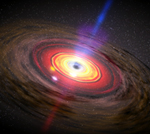 Click on image for high resolution. Click on image for high resolution. |
Scientists See Matter At Breakneck Speed Circling A Black Hole Scientists using a speed-gun technique typical of the highway patrol have clocked three separate clumps of hot iron gas whipping around a black hole at 20,000 miles per second. That's over 10 percent of light speed. The observation, made with the European Space Agency's XMM-Newton satellite, marks the first time scientists could trace individual blobs of shredded matter on a complete journey around a black hole. This provides a crucial measurement that has long been missing from black hole studies: an orbital period. Knowing this, scientists can measure black hole mass and other characteristics that have long eluded them. Credit: NASA/ESA. + Read more Animations: + Matter Circles Around a Black Hole (no audio) + Observing the Doppler Shift (animation with sound) + XMM Processing B-roll (no audio) |
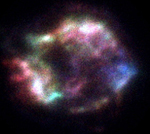 |
NASA Swift Mission Turns On, Sees A Blast of Bursts The NASA-led Swift mission has opened its doors to a flurry of gamma-ray burst action. Swift was launched from Cape Canaveral on November 20, 2004. Its primary goal is to unravel the mysteries of gamma-ray bursts which are fleeting explosions second only to the Big Bang in total energy output. Credit: NASA. + Read more Animations and Images: + Swift’s First Light (still image) + Supernova Remnant (still image) + Swift’s First Burst (no audio) + Gamma Ray Burst (no audio) + Swift Launch (b-roll with sound) |
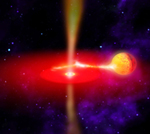 |
Surfs Up: Matter Rides On Waves of Spacetime Around Black Hole Scientists at Harvard and MIT say they have seen evidence of hot iron gas riding a ripple in space-time around a black hole, much like a surfer catching a gnarly wave. The observation confirms one important theory about how a black hole's extreme gravity can stretch light. This also paints an intriguing image of how a spinning black hole can drag the very fabric of space around with it, creating a choppy sea of space that distorts all that passes through it on a descent into the black hole. Credit: NASA. + Read more Animations: + Matter Rides on Wave of Space-time Around a Black Hole (no audio) + Lense-Thirring Precession (Visualization) – Dr. Fred Lamb, Univ. of Illinois |
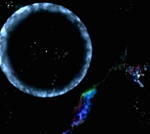 |
Cosmic Explosion Among Brightest In Recorded History Scientists using the Swift spacecraft have detected a flash of light from across the Galaxy so powerful that it bounced off the Moon and lit up the Earth's upper atmosphere. The light was the brightest ever detected in the history of recorded astronomy other than sunlight. Scientists call the event a "giant flare" from an unprecedented eruption on the surface of an exotic neutron star. Credit: NASA, NRAO/CfA/Gaensler, University of Hawaii. + Read more Animations and images: + Cosmic Explosion (no audio) + Location of SGR-1806 (no audio) + SGR-1806-20 Magnetar With Magnetic Field Lines (no audio) + Radio Data of SGR 1806-20 (images) |
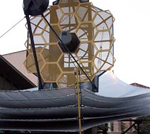 |
Full-Scale Model Of James Webb Space Telescope Unveiled At 21st National Space Symposium During the 21st National Space Symposium in Colorado Springs, CO, Northrop Grumman unveiled a full-scale engineering model of the James Webb Space Telescope (JWST). JWST will build on the discoveries of earlier space telescopes and open doors to a new understanding of the Universe. The model was built to show the scale and complexity involved in building JWST. JWST is scheduled to launch in 2011. Credit: NASA/Northrop Grumman. + Read more Animations: + Assembling a Model of Gigantic Proportions B-roll (video with sound) + Attendees View the JWST Model (video with sound) JWST Science Animations: (no audio) One, Two, Three |
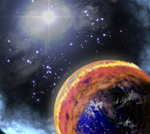 |
Stellar Explosions May Have Initiated Ancient Extinction On Earth Scientists say that a mass extinction on Earth hundreds of millions of years ago could have been triggered by a gamma-ray burst. The scientists do not have direct evidence that a gamma-ray burst activated the ancient extinction. The strength of their work is their atmospheric modeling -- essentially a "what if" scenario. They calculated that gamma-ray radiation from a relatively nearby stellar explosion could deplete up to half of the atmosphere's protective ozone layer. With the ozone layer damaged, ultraviolet radiation from the Sun could lead to a mass extinction. Credit: NASA. + Read more Animations and Images: + Cosmic Explosion (no audio) + Extreme Radiation Artist Concept (still image) + DNA Damage (visualization-no audio) + Trilobite Image (still image) – Professor Bruce Lieberman, Dept of Geology, Univ. of Kansas + SOHO Image (no audio) + Antarctic Ozone Hole (no audio) |
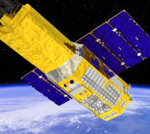 |
Japanese Launch X-Ray Satellite With NASA Instrument The Japan Aerospace Exploration Agency (JAXA) has launched a major new space observatory, called Astro-E2 to study black holes and the creation of chemical elements necessary for life. The observatory includes a pioneering X-ray detector developed at NASA's Goddard Space Flight Center (GSFC). The satellite was launched from the Uchinoura Space Center in southern Japan. Credit: NASA. + Read more Animation: Astro-E2’s Science Objectives Animation (no audio) |
 |
Scientists Watch Black Hole Born In Split Second Flash Of Light For the first time scientists have detected and pinned down the location of a so-called "short" gamma-ray burst, lasting only 50 milliseconds. The burst marks the birth of a black hole. Speculation on what could have caused the burst includes, perhaps a collision of two older black holes or two neutron stars. Multitudes of follow-up observations are planned; the answer might come in a few more days. Credit: NASA. Still image credit: Cenko, Soifer,Bian, Desai, Kulkarni (Caltech), Berger (Carnegie), Dey and Jannuzi (NOAO). + Read more Animations and Images: Neutron Star Collision (no audio) Ground-based Observation by W.M. Keck Observatory (Still Image). |
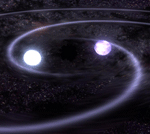 |
Orbiting Stars Flood Space With Exotic Gravitational Waves A scientist using NASA's Chandra X-ray Observatory has found that two white dwarf stars orbiting each other in a death grip, destined to merge, may be flooding space right now with gravitational waves. These waves are ripples in space-time predicted by Einstein but never detected directly. Einstein predicted that accelerating, massive objects emit gravitational waves, which propagate through space at light speed. A passing wave will cause the Earth, moon and all matter to bob, like a buoy on the ocean, subtly altering the distance between them. Credit: NASA/CXC. + Read more Animation: White Dwarf Gravitational Wave Merger (no audio) |
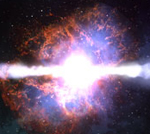 |
Scientist Watch Baby Black Hole Get To Work Fast Scientists using NASA's Swift satellite say they have found newborn black holes, just seconds old, in a confused state of existence, sloppily gorging on material falling into them while somehow propelling other material away at great speeds. These black holes are born in massive star explosions. An initial blast obliterates the star. Yet the chaotic black hole activity appears to re-energize the explosion again and again over the course of several minutes. This is a dramatically different view of star death, one that entails multiple explosive outbursts and not just a single bang, as previously thought. Credit: NASA. + Read more Animation: Double Gamma Ray Burst (no audio) |
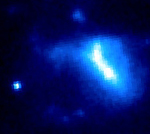 |
35 Year Old Mystery Solved In A Flash Scientists have solved a 35-year-old mystery of the origin of powerful, split-second flashes of light called short gamma-ray bursts. These flashes, brighter than a billion suns yet lasting only a few milliseconds, have been simply too fast to catch until now. Through unprecedented coordination of observations from a multitude of ground-based telescopes and NASA satellites, scientists have determined that the flashes arise from violent collisions, either between a black hole and a neutron star or between two neutron stars. In either scenario creates a new black hole. Credit: NASA. + Read more Animations and Images: Black Hole Swallows a Neutron Star (no audio) Multiple Observatories View GRB Afterglow (Images-no audio) HST Observations of GRB Afterglow (Images-no audio) Colliding Neutron Stars (no audio) Gamma Ray Light Comparison of Burst Intensity (no audio) HETE Comparison of 7/11/05 GRB in X-ray & Gamma Ray Light (no audio) GRB 050709 Location Map (Still Image) |
 |
Scientists See Light That May Be From First Objects In Universe Scientists using NASA's Spitzer Space Telescope say they have detected light that may be from the earliest objects in the universe. If confirmed, this landmark observation provides a glimpse of an era more than 13 billion years ago when, after the fading embers of the theorized Big Bang gave way to millions of years of pervasive darkness, the universe came alive. Credit: NASA/JPL-Caltech. + Read more Animations and Images: First Stars – Image One (Still Image) First Stars – Image Two (Still Image) Animation of the First Stars Turning On (no audio) |
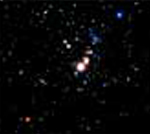 |
NASA's Chandra Observatory Catches X-Ray Super-Flares New results from NASA's Chandra X-ray Observatory about the Orion Nebula imply super-flares torched our young solar system. Such X-ray flares likely affected the planet-forming disk around the early sun, and may have enhanced the survival chances of Earth. Credit: NASA/Chandra X-ray Observatory. + Read more Animation: + X-Ray Flares From a “Young Sun” (no audio) |
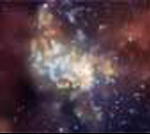 |
Stars Form Surprisingly Close To Milky Way's Black Hole NASA's Chandra X-ray Observatory has revealed a new generation of stars spawned by a super-massive black hole at the center of the Milky Way galaxy. This novel mode of star formation may solve several mysteries about these super-massive black holes that reside at the centers of nearly all galaxies. Credit: NASA/Chandra X-ray Observatory. + Read more Animation: + Stars Forming Around a Black Hole (no audio) |
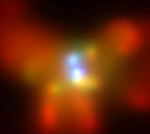 |
Best Of Chandra Images: Black Holes, Jets & Quasars Black holes are so dense and compact that nothing -- not even light -- can escape. Just outside their grasp, though, black holes can alight galaxies by expelling infalling gas and stars (known as quasars), or generate powerful high-energy jets flowing from spiraling disks that surround them. This video presents some of the best Chandra observations of black holes, jets & quasars. Credit: NASA/Chandra X-ray Observatory. + Read more Animation: + Black Holes, Jets & Quasars (no audio) |
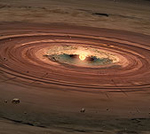 |
Astronomers Discover Beginnings of “Mini” Solar System NASA's Spitzer Space Telescope has spotted a dusty disc of planet-building material around an extraordinarily low-mass brown-dwarf. The brown dwarf, called OTS 44, is only 15 times the mass of Jupiter. The finding will help astronomers understand how and where planets form. Credit: NASA/JPL-Caltech. + Read more Image: + Formation of a “Mini” Solar System (Artist’s Concept) |
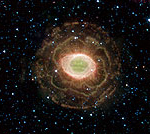 |
The Universe Sends A Celestial Valentine NASA's Spitzer Space Telescope and Cassini mission are providing a Valentine's Day memento with two new views of dazzling rings and a celestial flower. Credit: NASA/JPL-Caltech-Harvard-Smithsonian CfA-Caltech. + Read more Images: + Saturn’s Rings - Cassini Image Taken 12/12/2004 + Spitzer Image of the Ring Nebula |
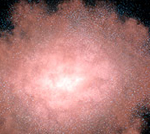 |
Spitzer Finds Galaxies Buried In Dust How do you hide something as big and bright as a galaxy? You smother it in cosmic dust. NASA's Spitzer Space Telescope saw through such dust to uncover a hidden population of monstrously bright galaxies approximately 11 billion light-years away. Credit: NASA/JPL-Caltech. + Read more Images: + Invisible Galaxy Comes to Life (Artist’s Concept) |
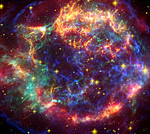 |
Spitzer Captures Echo Of Dead Star's Rumblings An enormous light echo etched in the sky by a fitful dead star was spotted by the infrared eyes of NASA's Spitzer Space Telescope. The surprising finding indicates Cassiopeia A, the remnant of a star that died in a supernova explosion 325 years ago, is not resting peacefully. Instead, this dead star likely shot out at least one burst of energy as recently as 50 years ago. Credit: NASA/JPL-Caltech. + Read more Images: + The Cry of Cassiopeia A |
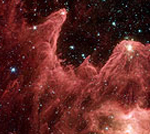 |
Spitzer Captures Cosmic Mountains Of Creation A new image from NASA's Spitzer Space Telescope reveals billowing mountains of dust ablaze with the fires of stellar youth. Spitzer shows us the eastern edge of a region known as W5, near the Perseus constellation. The colossal pillars resemble a mountain range more than 10 times the size of the pillars in the Eagle Nebula. Credit: NASA/JPL-Caltech. + Read more Animations And Images: + Spitzer’s “Mountains of Creation” (no audio) + Size Comparison to Hubble’s “Pillars of Creation” (no audio) |
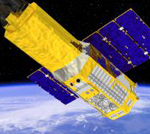 |
Astro-E 2 Spacecraft (Suzaku) Developed by the JAXA Institute of Space and Astronautical Science (ISAS) in collaboration with U.S. scientists, and other Japanese institutions, the Suzaku satellite, formerly known as Astro-E2, was launched on July 10, 2005. The Suzaku satellite will provide scientists with information to study extremely energetic objects like neutron stars, active and merging galaxies, black holes, and supernovae in the X-ray energy range. Credit: ISAS/JAXA. + Read more Animation: + Spacecraft Animation |
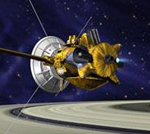 |
Cassini Spacecraft This animation shows the Cassini spacecraft in orbit around Saturn. During Cassini's four-year tour, scientists hope to gain a better understanding of Saturn, its famous rings, its magnetosphere, Titan and its other icy moons. Cassini was launched on October 15, 1997. Credit: NASA. + Read more Animation: + CassiniSpacecraft (no audio) |
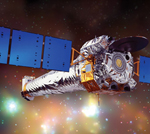 |
Chandra Spacecraft This animation shows the Cassini spacecraft in orbit around Saturn. During Cassini's four-year tour, scientists hope to gain a better understanding of Saturn, its famous rings, its magnetosphere, Titan and its other icy moons. Cassini was launched on October 15, 1997. Credit: NASA/CXC/NGST. + Read more Animation: + Spacecraft Animation |
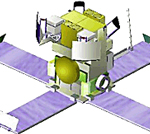 |
HETE-2 Spacecraft A key feature of HETE-2 is its superior response time. When HETE-2 alerts other spacecraft to a gamma ray burst, they are able to see the afterglow of the burst (similar to a cinder slowly fading). HETE-2's ability to relay the accurate location of each burst in real-time to space and ground-based optical and radio observatories has the ability to revolutionize the area of high-energy astrophysics. HETE-2 was launched on October 9, 2000 from the Kwajalein Missile Range in the Marshall Islands. Credit: NASA. + Read more Animation: + Spacecraft Animation (no audio) |
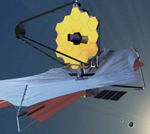 |
James Webb Space Telescope (JWST) JWST is designed to make observations in the far visible to the mid-infrared part of the spectrum. This wavelength coverage is different from that of the HST, which covers the range from the ultraviolet to the near-infrared. JWST will have a primary mirror diameter more than twice as large as HST giving it much more light gathering capability. JWST will also operate much farther from Earth giving it much simplified operations and pointing requirements compared with HST. JWST is scheduled to launch in 2013. Credit: Northrop Grumman Space Technology. + Read more Animation: + Spacecraft Animation (no audio) |
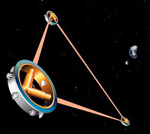 |
LISA Spacecraft The upcoming LISA Mission consists of three spacecraft orbiting the Sun in a triangular configuration, separated from each other by five million kilometers Each spacecraft will contain freely falling "proof masses" protected from all other forces except for gravity. The relative motion of the masses can be measured by combining laser beams shining between the spacecraft. Passing gravitational waves will ripple space and time, revealing their presence by altering the motion of the proof masses. Credit: NASA/JPL-Caltech. + Read more Animation: + Spacecraft Animation (no audio) |
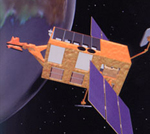 |
Rossi X-ray Timing Explorer (RXTE) The Rossi X-ray Timing Explorer (RXTE) is a satellite that observes the fast-moving, high-energy worlds of black holes, neutron stars, X-ray pulsars and X-ray bursts that light up the sky both randomly and periodically. To our eyes, the night sky seems relatively constant. Yet the x-ray universe is forever pulsing. RXTE was launched into low-Earth orbit on December 30, 1995, and is still going strong. Credit: NASA + Read more Animation: + Spacecraft Animation (no audio) |
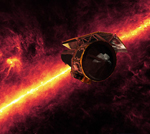 |
Spitzer Spacecraft This animation shows NASA's Spitzer Space Telescope observing in infrared. Spitzer's infrared detectors see through dense gas and dust to view distant galaxies, star forming regions, and planet-forming regions, and planet-forming discs around stars. The Space Infrared Telescope Spacecraft launched from Cape Canaveral Air Force Station in Florida on Monday, Aug. 25, 2003, at 1:35 a.m. EDT. Credit: NASA + Read more Animation: + Spacecraft Animation (no audio) |
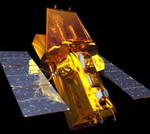 |
Swift Spacecraft With Swift, a NASA mission with international participation, scientists will now have a tool dedicated to answering these questions and solving the gamma-ray burst mystery. Its three instruments will give scientists the ability to scrutinize gamma-ray bursts like never before. Within seconds of detecting a burst, Swift will relay a burst's location to ground stations, allowing both ground-based and space-based telescopes around the world the opportunity to observe the burst's afterglow. Swift is part of NASA's medium explorer (MIDEX) program and was launched into a low-Earth orbit on a Delta 7320 rocket on November 20, 2004. Credit: NASA/ESA + Read more Animations: + Spacecraft Animation 1 (no audio) + Spacecraft Animation 2 (no audio) |
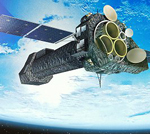 |
XMM-Newton X-ray Satellite The European Space Agency's XMM-Newton X-ray satellite launched on Dec. 10, 1999, from French Guiana on an Ariane-5 rocket. XMM is helping scientists to solve many cosmic mysteries, ranging from enigmatic black holes to the formation of galaxies. The XMM satellite studies cosmic x-rays which are generated in extremely violent processes. These x-rays are signatures of what occurred in the distant past when stars were born or died, and are clues to our future. Credit: ESA + Read more Animations: + Spacecraft Animation (no audio) |
MEDIA CONTACTS
Deanna Kekesi
NASA Goddard Space Flight Center
Greenbelt, MD
301-286-0041
Wade Sisler
NASA Goddard Space Flight Center
Greenbelt, MD
(301) 286-6256
Erica Hupp
NASA Headquarters
Washington, DC
202-358-1237
Steve Roy
Marshall Space Flight Center
Moffett Field, CA
(256) 544-0034
Gay Yee Hill
Jet Propulsion Lab
Pasadena, CA
(818) 354-0344
Goddard Space Flight Center